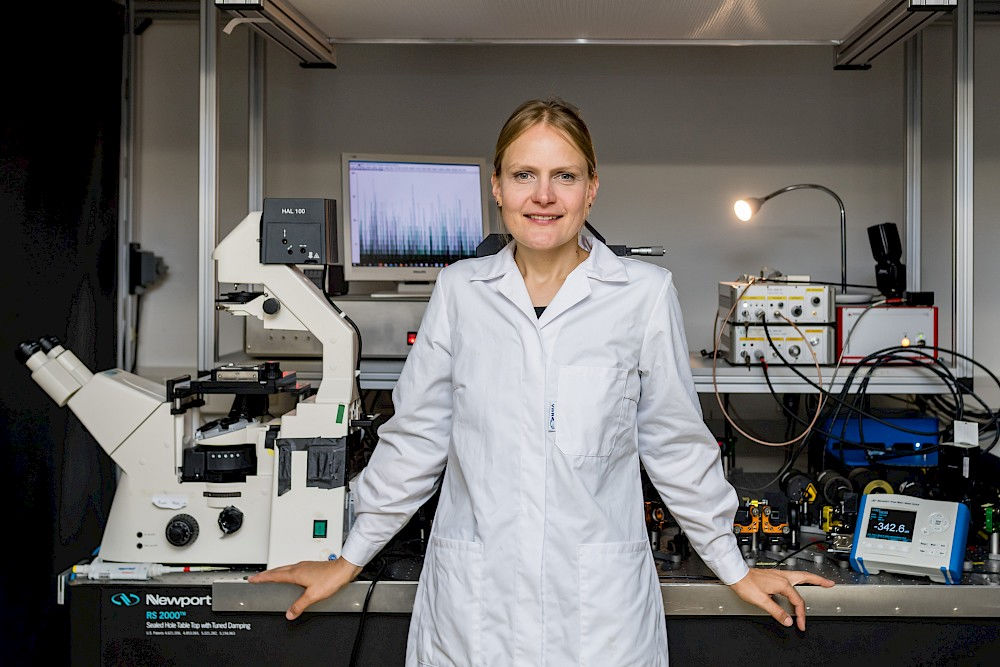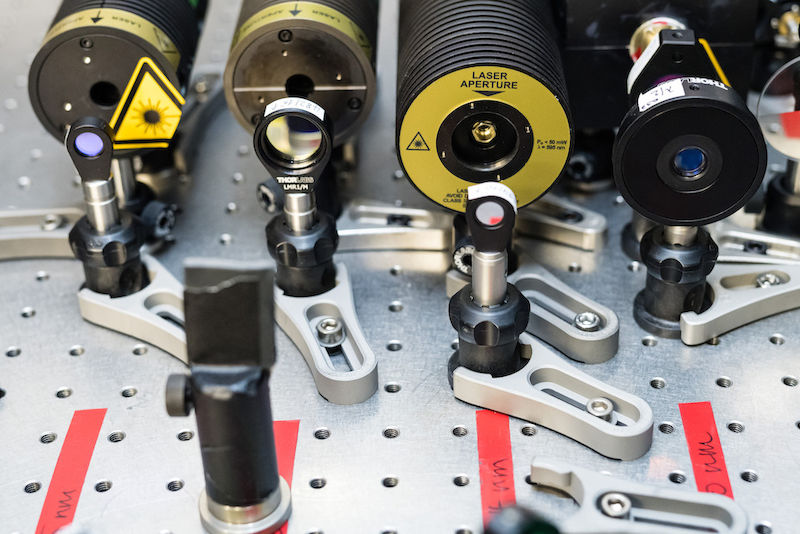When proteins assemble

It starts with the appearance of tiny individual accumulations of protein structures between brain cells; later there are more. Then nerve cells begin to die, the mental abilities of the affected person diminish, and their memory deteriorates. Years later the patient dies. There is still no cure for Alzheimer’s disease. Neither do doctors and biochemists know how the tiny - mostly 42 amino acids long - protein structures find each other at the beginning and how more and more of these peptides then attach to each other forming small and well-ordered structures called “fibrils” that announce the beginning of the end of the brain in Alzheimer’s patients. It is precisely this process that physicist Dr Maria Ott from the Institute of Biochemistry and Biotechnology is investigating. The scientist is not aiming to find a drug to treat the disease. Instead she wants to find answers to some very fundamental questions: How do the peptides that later form the dangerous structures self-assemble? And how does their immediate environment affect this process?
Starting with a part-time position
The 40-year-old scientist has been leading a junior research group at the Institute of Biochemistry and Biotechnology for two years. Four women and two men make up Maria Ott’s research team. For a long time, the scientist pursued her career on a part time basis. Shortly after the birth of her first child in 2010, who was born during her two-year stay abroad at the renowned Weizmann Institute in Israel, she returned to Germany. She wanted to take advantage of parental leave, says Ott – which, despite its child-friendliness, Israel does not offer.
In 2011, the young mother started a part-time physics job in Halle, which increased to an 80 per cent position in 2015 when she was promoted to project leader in the Collaborative Research Centre TRR 102 “Polymers Under Multiple Constraints”. You have to be well-organised, she says today. But she felt that it was also important to make time for her family. “It requires acceptance, something that I experienced,” says Ott. Talking with assistant professors as part of the mentoring program of the Central German University Alliance Halle-Jena-Leipzig and with her former supervisor also helped her prepare for her managerial tasks.
Now the scientist is a mother of two and has been working full-time for a year - on projects like the one on self-assembling peptides. Perhaps the answers to these basic questions will also lead to a drug that can treat Alzheimer’s patients and other illnesses one day many years from now. But first, Maria Ott is concentrating on observing the tiny peptides that combine to form larger structures. The physicist attaches a dye to these protein structures, which she can then excite to fluoresce so that she can observe them under a confocal fluorescence microscope. But which dye is best suited for this process? After all, it needs to adhere firmly to the tiny protein particle, but in no way block the sites where the peptides will later attach. This is precisely the process that needs to be studied. Maria Ott started by examining the adhesion of different dyes to the peptides. She began this work in the Collaborative Research Centre “Polymers Under Multiple Constraints”. She finally found a dye called “Atto488” that binds to one end of the peptide and shimmers green at a wavelength of 488 nanometres when excited.

Maria Ott only labels every fiftieth peptide with this dye so that the individual steps in the formation of the structures are impacted as little as possible. All of the other molecules can therefore interact with each other in a completely natural way. Then the researcher observes under a confocal fluorescence microscope how tiny green dots move inside a very minute part of a tiny droplet of solution, which is only a millionth of a millionth of a millilitre. Physicists call this volume a “femtolitre”.
Sometimes the green shimmering dots slow down as they diffuse through this teeny-tiny volume of solution. “Then one of the tiny peptides attaches itself to the labelled biomolecule,” explains Maria Ott. Later, the dye that is drifting through the solvent gradually slows down again when the next peptide attaches itself.
Maria Ott and her colleagues do not have to observe these processes themselves. Sensors and a computer programme written by Ott assume this task. “In the end, we compare the measurement results with model predictions and obtain the decisive clue as to how the peptides come together,” explains the biophysicist. The initial results are already emerging. The peptides often seem to assemble on surfaces such as the walls of the reaction vessels. Some researchers are considering whether the dangerous structures are in fact forming on cell membranes in the brains of Alzheimer’s patients. This isn’t a big surprise to physicists because similar processes also often begin on surfaces. For example, the moisture in the air often begins to condense onto tiny, floating particles like dust.
There are now indications from various laboratories that the fibrils themselves cause much less damage in the brain than previously suspected. Smaller units, which consist of much fewer peptides and are only at an intermediate stage, appear to be much more dangerous. Maria Ott is investigating the formation of precisely these particles.
Working on hormones
The biophysicist also examines the formation of larger structures of other biomolecules, which seemingly pose no threat to the organism. Parathyroid glands produce the parathyroid hormone that regulates an organism’s important calcium balance. This hormone also forms larger protein structures which are stored in so-called “granules”. When the organism needs larger amounts of the parathyroid hormone, these granules and the protein structures dissolve and the hormones can quickly be utilised. “Of course, we would really like to understand the differences between the formation of the parathyroid hormone structures and the fibrils that play a role in Alzheimer’s disease,” explains Maria Ott. Once again tiny dots of colour move around inside tiny droplets. Some of these droplets contain parathyroid hormones in which individual amino acids have been replaced using biotech methods and which may therefore behave differently from the unmodified hormone.
Maria Ott is also interested in the parathyroid hormone for a completely different reason. Only a small proportion of its 84 amino acids assemble themselves into larger units with a relatively rigid structure. The structure of the remaining amino acids is highly flexible. When Maria Ott attaches a different dye to each of the ends of such a flexible protein, which can excite each other to fluoresce, she is able to observe the movements of the two ends. And over time, she is able to discover the different structures that these highly malleable biomolecules adopt. Such investigations are also of scientific interest because the structure of around 40 per cent of all proteins is flexible and scientists currently know very little about them.
In any case, the scientist enjoys tackling research projects that have received little attention in the past. For example, thin films made of special plastics, which can transform sunlight into electricity in organic solar cells, are produced in solvents that have an enormous influence on their properties. It is precisely this joining together of polymers in solutions that can be investigated well using Maria Ott’s methods and which could one day lead to improvements in the production of this inexpensive alternative to conventional solar cells.
Such experiments have allowed the researcher to return to her roots - to physics. After all, she graduated with a degree in classical physics from MLU in 2005. After returning to Halle from Israel, Maria Ott spent seven years working at the Institute of Physics in different research groups that specialised in polymer physics. In 2018, her junior research group moved from the Faculty of Natural Sciences II to the Institute of Biochemistry and Biotechnology in the Faculty of Natural Sciences I, where it has since been applying the methods of physics to protein research. Starting last year, Ott has also begun passing on her expertise to the next generation of young researchers as the project leader of the Research Training Group 2467 “Intrinsically Disordered Proteins”, thereby filling a permanent mid-level academic position, something that has become so rare.
Her next goal is to do a post-doc degree. When her second child starts school in two years, she wants to have mastered this career step - again in physics. She has not stepped away completely from the subject, though, as Maria Ott is currently teaching at the Faculties of Natural Science I and II.
Dr Maria Ott
Institute of Biochemistry and Biotechnology
Tel. +49 345 55-24946
Mail: maria.ott@bct.uni-halle.de
